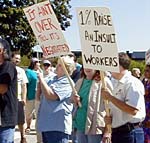By Patty Marsicano, Minnesota Public Radio
September 5, 2001
The University of Minnesota is welcoming back students for the beginning of the fall semester. The challenge for many of the school's almost 40,000 undergraduates is figuring out how to pay for the rising cost of an education.
| |
|
|
|
||
WASHINGTON AVENUE, THE HEART of the university's East Bank campus, is filled with cars, bikes, and pedestrians as students hurry about their business. Some, like Lisa Mathews, have a lot on their mind. "I really want to finish my major," she says. "I have two years left and a lot to do so hopefully I get my volunteer hours in, and I'm training to be an EMT so... Just medical school, get my MCADs done, so I have a lot to do in the next two years."
The re-opening of school means a lot to local merchants. Expresso Expose is an unassuming coffee shop on the East Bank. Manager Toby Mroczek says the first day of school is also a busy time for the shop "because you got the freshmen that aren't really that familiar with the campus area, so they're here checking out different coffee shops they can go to, so we get a lot of freshmen business, but then we also get grad students coming back and what not. So the first day is pretty hectic around here," he says.
Students will have to budget their coffee money a little more carefully this year; their tuition and fees are going up by an average of 13 percent. That works out to about $670 more per student per semester. University administration approved the hike this summer in response to getting much lower-than-requested operating funds from the state Legislature.
Freshman Luke Sheets, 17, has his finances figured out. The computer science major will take advantage of the university's ROTC program, which means he'll have to serve in the military upon graduation. "If you get a 2.5, you're eligible for scholarships, they can pay for your tuition, pay for your books. They even give you a small stipend, which is $250 a month for spending money."
But most students choose other ways to fund their education. University of Minnesota Board of Regent Chairwoman Maureen Reed, speaking on MPR's Midmorning on Tuesday, said most U of M students have to work. "I think the figure is somewhere around 85 percent of students at the University of Minnesota hold jobs. This is not true at other institutions. That is a very high percent of working students that we serve at the University of Minnesota."
And financial aid, while still available, is getting increasingly expensive. U of M Interim Director of Student Finance Susan Sinsabaugh says the trend has been taking shape since about 1980. "Twenty years ago, there were more scholarships and grant money available as a percentage of the total package, whereas today the preponderance of everybody's package is loans," according to Sinsabaugh.
Sinsabaugh says the phenomenon represents a shift in philosophy. "There's a greater assumption today that helping students finance their education means allowing them to borrow money at reduced rates rather than providing the funds outright."
But there's no sign the higher cost of an education is keeping students away. In fact, because of bulging freshmen enrollment, three U of M schools say rising enrollments are forcing them to raise admissions standards starting next school year.
Related Link
MPR's Universal U project

